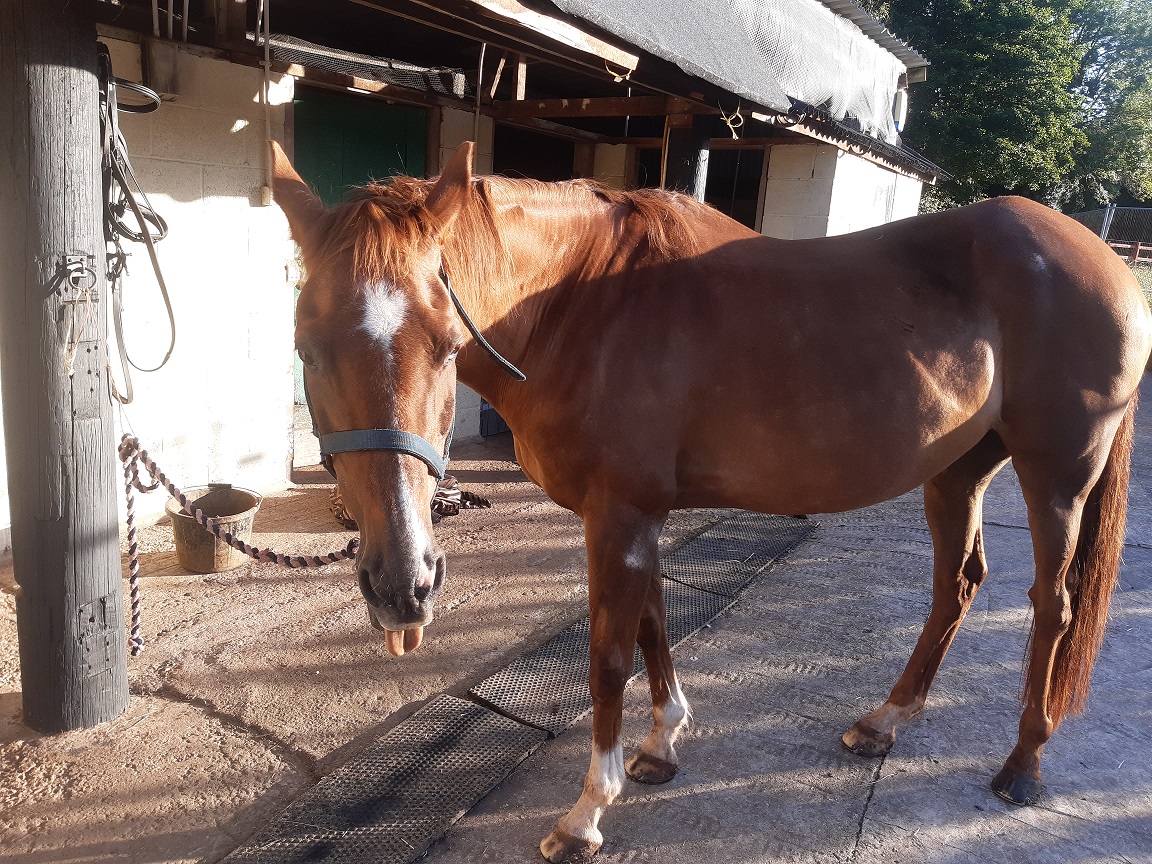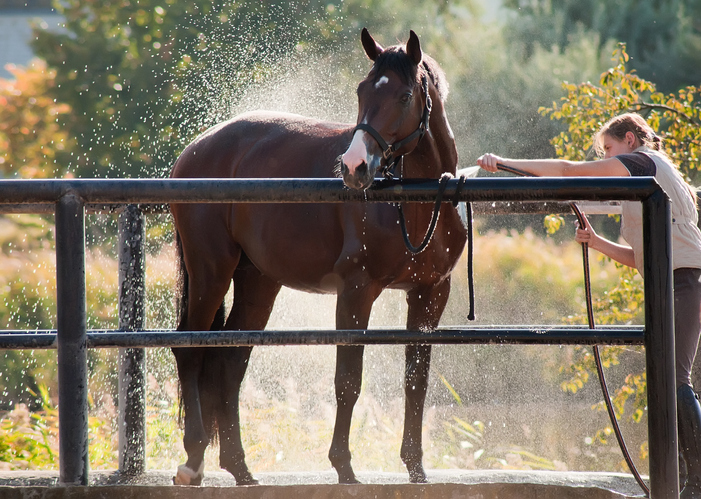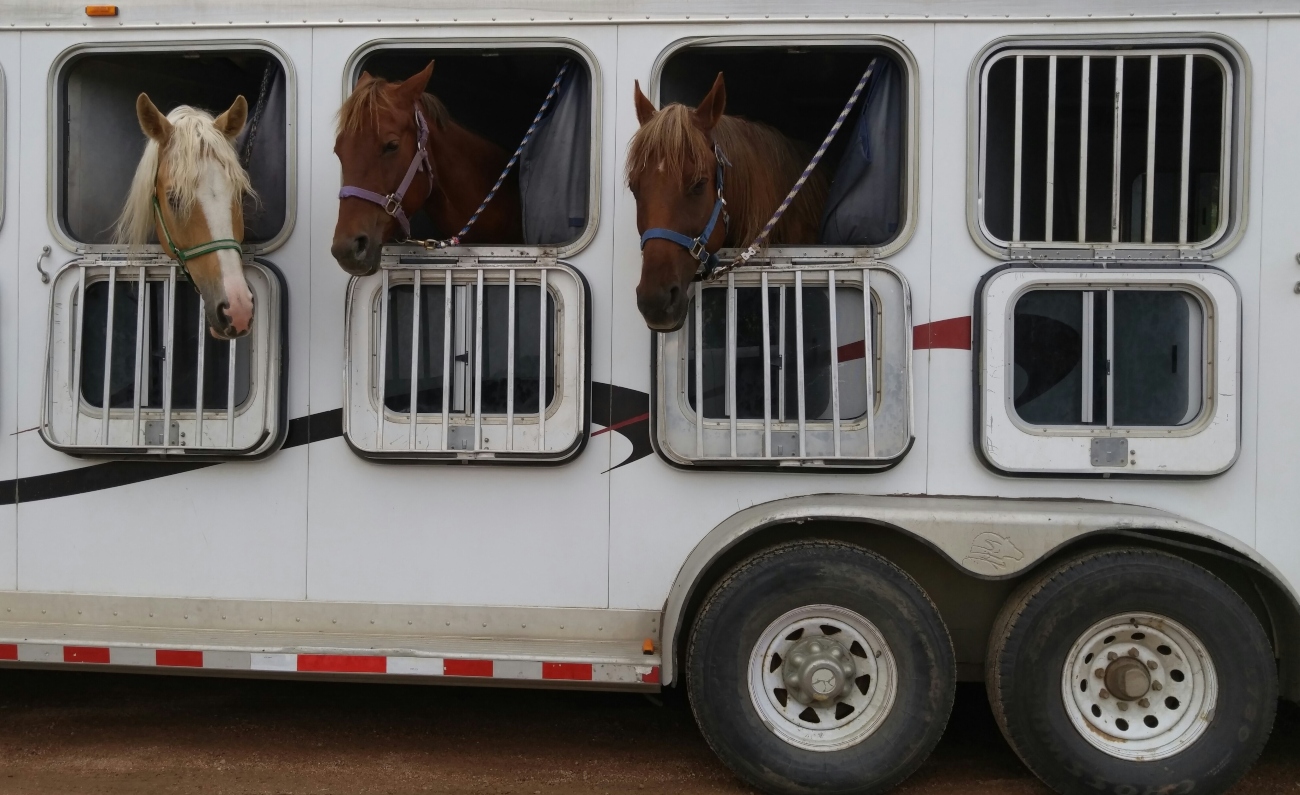Whether you’re a weekend hacker or a serious competitor, tying a horse safely and securely is an equestrian basic. But there's much more to it than meets the eye. Here at Equesure we’ve got some important tips on how to do it safely and what to avoid.
As we know, there’s never a one-size-fits-all approach when it comes to our equine friends. All horses react differently when tied up, particularly when travelling in the confined space of a horsebox.
Whether your horse loves or loathes travel, make sure you have the right horse insurance in place before you set off. The range of comprehensive policies available through Equesure can cover you for horsebox damage caused by your horse among many other things.

When should a horse be tied up?
Many horse owners take tying up their horse for granted. From brushing, tacking up, and cleaning their feet, to vet and farrier visits, it’s often important to keep your horse in one place, for both their safety and yours. Using cross-ties in stables, hitched trailers at shows or fence posts, trees, and almost anything else you think is stable and strong.
Indeed, the Blue Cross animal charity recommends horses should always be tied up when being groomed or tacked-up, even in a stable. This enables you to move calmly and confidently around the equine, without the fear of becoming trapped in a corner and potentially injured.
But in some situations being tied up just isn’t the right thing for a particular horse and their owner. And there are plenty of owners who avoid tying their horses unless they really have to. But if you are going to do it then it’s important to do it right.
How to tie up horses – Dos and don’ts
Do use the right equipment. A well-fitting safety or breakaway headcollar with leather or metal clips designed to snap under extreme tension is a must. If a horse panics, serious injury could occur if the lead rope holds fast.
Don't use the reins to tie up your horse, or a lead that's attached to the bit. If your horse were to pull back, serious pain and injury could be caused to their mouth. Not to mention a long-term fear of being tied up. Instead, tie your horse by a lead rope connected to the headcollar. This can then be secured through a loop of string attached to the tying-up ring.
Do use a suitable length of rope that’s in decent condition. All-cotton ropes tend to be easier on your hands and are less likely than synthetic ropes to cause that ‘burn’ when pulled rapidly across your skin.
Don’t tie them up close to other horses and temptations such as food sources that might cause them to pull and get themselves in a tangle. No matter how well-mannered your horse is, they are still animals that work on instinct. Perhaps your horse is a mare, and she’s in heat? Or perhaps they’re a fiery and temperamental stallion? It's much better to keep your equine out of trouble when tied up for everyone’s sake.
Do tie them to a solid object they can’t break or pull over if they become frightened or rear up.. Tie a short loop of string around the object and then tie the horse’s rope to that string, instead of the object itself. This means if the horse does decide to make a break for it, property damage will be minimised.
Don’t tie them to a gate, it’s a recipe for disaster. Even tying them close by when other horses or riders are using the gateway, can put your horse and them at risk. Even being near a gate latch can be enough to cause a problem as their headcollar, lead rope, or even their flesh could get caught on it. Horses are such powerful creatures that it really doesn’t take long for serious damage to be inflicted.
Do tie them to a wooden fence post rather than a fence rail. If you tie them to a rail, it doesn’t take too much for the horse to sit back and pull the rail off the posts. Then you’ll have a frightened horse running around the field trailing a 20-foot piece of wood with nails sticking out of it. The damage potentially inflicted on themselves, field mates and nearby people doesn’t bear thinking about.
Don't tie them up so short they can’t comfortably move their head and end up feeling claustrophobic. Or so long that the rope hangs down where it could entangle a leg and cause injury. It’s generally recommended to leave about 2 to 3 feet of rope between the horse and the object it’s been tied to. A popular mnemonic for both height and length is ‘Eye high and arm's length.’
Do use a safety or quick-release knot that will come loose with a pull in the event of an emergency. As an alternative to a quick-release knot, a blocker tie ring can secure your horse without the need to tie them fast. They’re a superb tool for youngsters or those in need of retraining who pull back and panic when tied.
Don’t tie them to an object on or near the ground such as a log, or trailer hitch. If you do, it’s all too easy for the horse to step on the rope, trip on it, or otherwise get tangled up, and potentially suffer serious injury. It’s much better to tie a horse to something at eye-level or higher. Although, be careful they’re not tied to something so high that their head movement is restricted.

Do check the ground when tying up. This might seem obvious, but if you get distracted, it's all too easy to forget to look around on the ground when you tie-up. If the horse steps in a hole, they can lose balance, panic and cause an injury pretty quickly. Not to mention the dangers of nails and other debris hiding in plain sight that they could step on or run into! If the worst should happen and they step on a nail then read our recent guide to what to do.
Don’t leave a horse tied up without checking in on them regularly, especially if they’re new to being tied up. If a horse will be tied for a long time, then it’s important to ensure there’s food and water freely available, and the horse is sheltered from the elements.
Do keep a knife handy for emergency situations. If the horse manages to pull the knot tight and you need to release it in a hurry, cut through the rope between the post or ring and the knot. Be sure to hold the knife so the blade is facing away from you both, so there’s no chance of injury if the rope suddenly gives way. A marlinspike is also ideal for working loose overly tight knots.
Don’t remove the head collar before untying the horse. Instead, untie the horse first and then turn the horse in the direction you want them to go before you remove the headcollar.
Do be careful moving around tied horses. Never step over or under a rope that’s being used to tie a horse. And always remain well out of kicking range. Avoid startling them by speaking in a soft voice before approaching them. Try to keep your hands on the horse as you walk alongside it.
Don’t tie them to an unhitched trailer. Trailers may be big and strong but they can still move when not fixed to your 4x4. However horseboxes are a lot more sturdy and suitable for tying up when you are out at a show. Use the tie hooks only, never any moving, removable or breakable part, plus don’t forget about that handy string to help break away in an emergency. Having comprehensive horsebox insurance is a great way to protect against damage done by your horse, but also from vandalism and windscreen repairs. Make sure you get a policy that covers all of your needs. If in any doubt, ask the team at Equesure to explain what your policy covers and any exclusions.
Do have an ‘out’ for the horse handler. It doesn’t matter where you’ve tied your horse up, they must be in a position that you always have a way out. Finding yourself pinned between the horse and the unmovable object like a fence, a stall wall or a trailer side is a terrifying prospect.
Knots every horse owner should know
To be sure you’re tying your horse up safely and correctly, there are some essential knots that everyone needs to know how to do. Always try tying these knots when your horse isn’t around. You don’t want to get yourself in a muddle when you’ve got an impatient equine on your hands and the pressure is on!
This quick-release knot (or slip knot) is a great one to get started with as it’s super-fast to tie and to undo. And, if your horse has learned how to set itself free, there’s also a handy trick to stop those equine escapologists from breaking free!
- Step 1: Pass the loose end of the lead rope through the safety string loop (or through the tying-up ring or around the post).
- Step 2: Feed the loose end over the rope and around underneath to create a loop.
- Step 3: Fold the loose end into a bight (a small loop).
- Step 4: Pull the bight through the loop.
- Step 5: Pull on the standing end to tighten the knot and hey presto you’ve a quick-release knot. Simply pull on the loose end to undo.
- Step 6: Some horses have worked out that by pulling on the loose end of the rope with their mouths they can free themselves. This is very annoying! To prevent this from happening, simply tuck the loose end of the rope back through the loop. Now the knot can no longer be untied by pulling on the loose end.

Other knots worth exploring include:
- Bowline Knot
Another commonly used, quick-release knot. It’s very useful for equestrians, in particular, as it won’t tighten when the rope is pulled. This makes it perfect to use if you need to quickly and safely tie a rope around a horse’s neck when leading them.
- Highwayman’s Hitch
A quick-release knot, allegedly used by highway robbers back in the days when riding on horseback was the fastest way to travel. Today it’s often used to tie horses during travel in a horsebox or trailer.
- Clove Hitch
Often considered one of the most important knots to learn in any walk of life. It’s ideal for tying your horse to a smooth pole, ring or post. Because the knot clamps down it doesn’t slide along or down. Be aware that it isn’t quite as easy to untie if it gets pulled very hard.
Find specialist horsebox insurance at Equesure today
Tying your horse up securely is especially important when you’re travelling around. Whether you’re driving a 3.5 tonne horsebox or after something even more substantial, the helpful team of insurance specialists at Equesure will work hard to find the right cover for your requirements and budget.
Our team has over 60 years of experience in the horsebox insurance market, finding cover for models by the likes of Equi-Trek, Equimark, Tristar, Ascot, Empire, Oakley, John Oates and many more.
Obtaining insurance through Equesure can give you a range of benefits including breakdown cover, so you don’t need to worry about your horsebox breaking down and leaving you far from home.
Other benefits can also include:
- Comprehensive and third party, fire and theft
- Cover for social, domestic and leisure
- Business use available
- Limited mileage discounts
- Windscreen cover on comprehensive policies
- Personal accident cover on comprehensive policies
- Values up to £750,000
- Legal cover available with all policies
- EU cover included on all policies
Getting a horsebox insurance quote is straightforward with Equesure.






